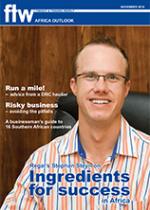Taking Höegh Autoliners on
board as partners provided
the spark needed to fire up
traffic through Grindrod’s Maputo
car terminal, says general manager
Pieter Venter.
When the vehicle terminal
opened in 2007, traffic was slow,
and it seemed the sceptics were
being proved right.
The catalyst proved to be having
a shipping line as a partner. Höegh,
which purchased a 30% share in the
terminal, introduced new services
and started using the terminal as a
hub for transhipments.
Various makes of vehicles are
now shipped from manufacturing
plants in the East to South East Asia
via Maputo.
Ro-Ro services up the East
coast have also been introduced to
transport vehicles into the African
market. Maputo now serves
Luanda, Lagos and Tema. Other
transhipment destinations through
Maputo are the Indian Ocean
Islands, South East Asia, Oceania
and the USA.
Volumes of imports of used cars
and commercial vehicles for the
Mozambican, Botswana, Zambia,
Malawi and Zimbabwean markets
are also growing.
“One of the things we underestimated
was the demand for high
and heavy vehicles,” says Venter.
The terminal had a number of
earth movers, truck tractors and
big trailers in the yard when FTW
visited.
The terminal also handles imports
and exports for South African
original equipment manufacturers
(OEMs) and importers.
It is now gearing up for OEMs
such as Ford and BMW, which are
evaluating Maputo as their main
point for imports and exports.
Nissan already makes use of the
terminal.
Venter says operations manager
Domingo Bie is a Six Sigma expert
who was recruited to ensure that
the terminal complies with the
requirements of potential clients
and to manage the operational
aspect of the facility.
At the same time Venter, who
was responsible for the construction
of the first phase of the car terminal,
is ready to put his hard hat back on
again. “Phase two is going to
happen a lot quicker than we
anticipated, and may start at
the beginning of next year,”
he says.
The design was completed
a year and a half ago.
It will take the capacity of
the terminal from 52 000 to
152 000 vehicles a year.
Responding to complaints
about high storage costs, he
said “we are a car terminal,
not a storage depot. The fees
are there to encourage people
to take their vehicles out as
soon as possible.
“Storage periods are
aligned with customs
clearance dwell times and are
generous in that regard,” he
says.
The terminal has an inhouse
transit clearing agency
to help transit clients speed up
the process and to pre-clear
the vehicles.
Traffic building up at car terminal
03 Dec 2010 - by Ed Richardson
0 Comments
Africa Outlook 2010

03 Dec 2010
03 Dec 2010
03 Dec 2010
03 Dec 2010
03 Dec 2010
03 Dec 2010
Border Beat
Poll
Featured Jobs
New
